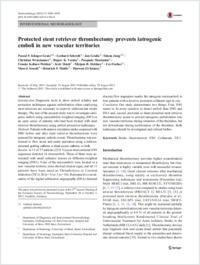Protected stent retriever thrombectomy prevents iatrogenic emboli in new vascular territories.
- Klinger-Gratz PP Department of Diagnostic and Interventional Neuroradiology, Inselspital, Freiburgstrasse 10, Bern University Hospital and University of Bern, 3010, Bern, Switzerland.
- Schroth G Department of Diagnostic and Interventional Neuroradiology, Inselspital, Freiburgstrasse 10, Bern University Hospital and University of Bern, 3010, Bern, Switzerland. gerhard.schroth@insel.ch.
- Gralla J Department of Diagnostic and Interventional Neuroradiology, Inselspital, Freiburgstrasse 10, Bern University Hospital and University of Bern, 3010, Bern, Switzerland.
- Jung S Department of Diagnostic and Interventional Neuroradiology, Inselspital, Freiburgstrasse 10, Bern University Hospital and University of Bern, 3010, Bern, Switzerland.
- Weisstanner C Department of Diagnostic and Interventional Neuroradiology, Inselspital, Freiburgstrasse 10, Bern University Hospital and University of Bern, 3010, Bern, Switzerland.
- Verma RK Department of Diagnostic and Interventional Neuroradiology, Inselspital, Freiburgstrasse 10, Bern University Hospital and University of Bern, 3010, Bern, Switzerland.
- Mordasini P Department of Diagnostic and Interventional Neuroradiology, Inselspital, Freiburgstrasse 10, Bern University Hospital and University of Bern, 3010, Bern, Switzerland.
- Kellner-Weldon F Department of Diagnostic and Interventional Neuroradiology, Inselspital, Freiburgstrasse 10, Bern University Hospital and University of Bern, 3010, Bern, Switzerland.
- Hsieh K Department of Diagnostic and Interventional Neuroradiology, Inselspital, Freiburgstrasse 10, Bern University Hospital and University of Bern, 3010, Bern, Switzerland.
- Heldner MR Department of Neurology, Inselspital, Bern University Hospital and University of Bern, Bern, Switzerland.
- Fischer U Department of Neurology, Inselspital, Bern University Hospital and University of Bern, Bern, Switzerland.
- Arnold M Department of Neurology, Inselspital, Bern University Hospital and University of Bern, Bern, Switzerland.
- Mattle HP Department of Neurology, Inselspital, Bern University Hospital and University of Bern, Bern, Switzerland.
- El-Koussy M Department of Diagnostic and Interventional Neuroradiology, Inselspital, Freiburgstrasse 10, Bern University Hospital and University of Bern, 3010, Bern, Switzerland.
- 2015-08-31
Published in:
- Neuroradiology. - 2015
Collaterals
SWI
Stent retriever
Stroke
TICI
Aged
Angiography, Digital Subtraction
Device Removal
Equipment Failure Analysis
Female
Humans
Iatrogenic Disease
Intracranial Embolism
Intracranial Thrombosis
Magnetic Resonance Imaging
Male
Mechanical Thrombolysis
Middle Aged
Prognosis
Prosthesis Design
Stents
Treatment Outcome
English
INTRODUCTION
Diagnostic tools to show emboli reliably and protection techniques against embolization when employing stent retrievers are necessary to improve endovascular stroke therapy. The aim of the present study was to investigate iatrogenic emboli using susceptibility-weighted imaging (SWI) in an open series of patients who had been treated with stent retriever thrombectomy using emboli protection techniques.
METHODS
Patients with anterior circulation stroke examined with MRI before and after stent retriever thrombectomy were assessed for iatrogenic embolic events. Thrombectomy was performed in flow arrest and under aspiration using a balloon-mounted guiding catheter, a distal access catheter, or both.
RESULTS
In 13 of 57 patients (22.8%) post-interventional SWI sequences detected 16 microemboli. Three of them were associated with small ischemic lesions on diffusion-weighted imaging (DWI). None of the microemboli were located in a new vascular territory, none showed clinical signs, and all 13 patients have been rated as Thrombolysis in Cerebral Infarction (TICI) 2b (n = 3) or 3 (n = 10). Retrospective reevaluation of the digital subtraction angiography (DSA) detected discrete flow stagnation nearby the iatrogenic microemboli in four patients with a positive persistent collateral sign in one.
CONCLUSION
Our study demonstrates two things: First, SWI seems to be more sensitive to detect emboli than DWI and DSA and, second, proximal or distal protected stent retriever thrombectomy seems to prevent iatrogenic embolization into new vascular territories during retraction of the thrombus, but not downstream during mobilization of the thrombus. Both techniques should be investigated and refined further.
Diagnostic tools to show emboli reliably and protection techniques against embolization when employing stent retrievers are necessary to improve endovascular stroke therapy. The aim of the present study was to investigate iatrogenic emboli using susceptibility-weighted imaging (SWI) in an open series of patients who had been treated with stent retriever thrombectomy using emboli protection techniques.
METHODS
Patients with anterior circulation stroke examined with MRI before and after stent retriever thrombectomy were assessed for iatrogenic embolic events. Thrombectomy was performed in flow arrest and under aspiration using a balloon-mounted guiding catheter, a distal access catheter, or both.
RESULTS
In 13 of 57 patients (22.8%) post-interventional SWI sequences detected 16 microemboli. Three of them were associated with small ischemic lesions on diffusion-weighted imaging (DWI). None of the microemboli were located in a new vascular territory, none showed clinical signs, and all 13 patients have been rated as Thrombolysis in Cerebral Infarction (TICI) 2b (n = 3) or 3 (n = 10). Retrospective reevaluation of the digital subtraction angiography (DSA) detected discrete flow stagnation nearby the iatrogenic microemboli in four patients with a positive persistent collateral sign in one.
CONCLUSION
Our study demonstrates two things: First, SWI seems to be more sensitive to detect emboli than DWI and DSA and, second, proximal or distal protected stent retriever thrombectomy seems to prevent iatrogenic embolization into new vascular territories during retraction of the thrombus, but not downstream during mobilization of the thrombus. Both techniques should be investigated and refined further.
- Language
-
- English
- Open access status
- hybrid
- Identifiers
-
- DOI 10.1007/s00234-015-1583-8
- PMID 26319999
- Persistent URL
- https://sonar.rero.ch/global/documents/269577
Statistics
Document views: 17
File downloads:
- fulltext.pdf: 0
